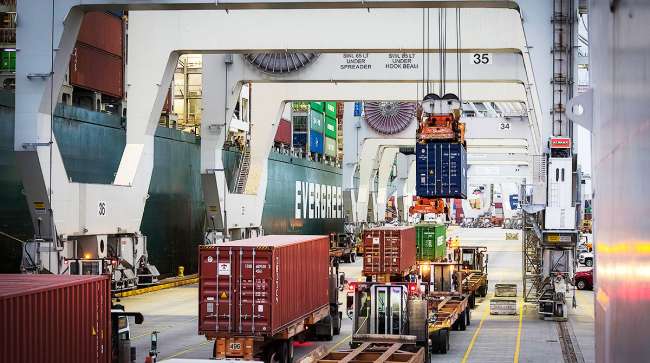Senior Reporter
Port of Savannah Eliminates Saturday Truck Operations

[Ensure you have all the info you need in these unprecedented times. Subscribe now.]
The Port of Savannah, the second busiest on the East Coast, is closing operations on Saturdays to truck drivers, effective immediately, as business slows due to the coronavirus pandemic.
Port Executive Director Griff Lynch told Transport Topics the decision to cut the port’s schedule from six days to five and eliminating truck hours would have minimal impact on beneficial cargo owners.
Georgia’s ports continue steady operation with normal, 24-hour vessel operations and terminal services, as well as Monday-Friday truck gate hours from 6 a.m. to 6 p.m. in #Savannah. #GeorgiaPorts #gaports #supplychain #logistics #containers pic.twitter.com/ji20qyPQue
— Georgia Ports (@GaPorts) March 31, 2020
“As we look at services and costs to cut when we’re kind of down on the volume as a result of the virus,” he said, “it was kind of a no-brainer to sit back and remove this service when it’s nice to have, but we don’t need to have everything. We’re running a business.”
Lynch said the one-day cut would save the port tens of thousands of dollars.
“The Georgia Ports had formally operated with a six-day week, and it was the standard operating procedure to have a Saturday gate for our trucking customers, and we did it a long time, and it’s been a great thing,” he said.
“But most of our truck customers are Monday through Friday, and if you look at any normal day when service is normal, we’ll handle from 10,500 to 13,000 trucks a day. Where on a Saturday, we do 1,500 and on a really strong day 2,000.”
In February, officials said the facility hit a record for that month since it has been tracking 20-foot-equivalent container volume levels back to 2003. Workers processed 364,406 TEUs, up 17% from a year ago, when workers moved 312,042.
But Lynch said that, like port officials at other facilities across the country, he is anticipating a downturn in the coming months.
“February was great; it’s probably the last record we’ll have for a while. We knew that, going into March,” he said. “Like all ports, we’re trying to figure out what’s happening here and how we can react to that. We’re seeing a March that will be down somewhere in the neighborhood of 15% to 20%.”
Lynch says April’s TEU numbers probably will be down in that range as well.
The Port of Savannah has one of the most aggressive expansion plans among ports in the U.S. with the goal of doubling the number of TEUs processed as many as 11 million during the next 10 years.
If the port reaches that goal, it will exceed the No. 1 port in the country, Los Angeles, which processed 9.3 million containers in 2019, a 1.2% decrease from 2018’s record.
This year alone, the port will add six cranes, which will bring to 36 the total number in operation, more than any port in North America. Twelve additional cranes will be delivered and in service by 2027. Plus, the Army Corps of Engineers is in the final stage of a massive dredging project.
To accommodate increasing intermodal and rail demand, the port is in the middle of a $220 million expansion of its rail infrastructure. The port will then have direct, three-day rail service between Savannah and Chicago capable of running 2-mile-long freight trains in both directions. The Mason Mega Rail Terminal will be the largest on-dock rail facility at any port in North America.
Lynch says that despite the economic downturn the country and the world are experiencing because of the coronavirus, the port is proceeding with most of its expansion plans.
“Clearly, our team is now looking at our list of capital projects, and we are going to reprioritize those based on what we see happening,” he said. “Our projects are driven by the revenue we generate; we do the best we can to run this like a business.
“There’s no one out there helping the Georgia Ports Authority from a funding standpoint. That’s always been the way the Georgia ports are run. If we want to do a project, we have to pay for it.”
Coronavirus notwithstanding, Lynch said his port and others would get through this crisis. And one thing is certain: The Panama Canal expansion, completed in 2016, changed the course of port operations. Facilities on the East Coast, in particular, now routinely load and unload ships carrying more than 14,000 TEUs.
“There will be projects that get delayed or postponed as a result of this,” he said. “We already have a lot of customers that are coming to our port with 10,000, up to 15,000 TEU ships, and we are committed to providing as many berths as we can to service those vessels, and we have a plan to create an additional 15,000-, 16,000-TEU berth and larger than that. We’re not going to stop and put the brakes on that project, because that’s already a need that we have.”
Want more news? Listen to today's daily briefing:




